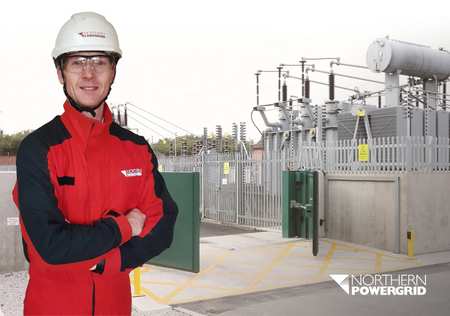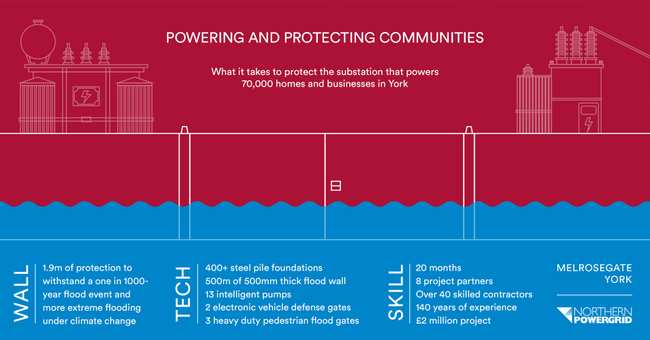
Climate Change Adaptation
Climate change is expected to bring more intense and longer duration storms, droughts and extreme weather to the UK over the next century.
Whilst we cannot fully predict the extent of change, we can prepare for the worst outcomes, to protect our network and the essential supply of electricity that it provides.
Reducing emissions is important in mitigating the more severe effects of climate change, while adapting to the effects that we can already expect is vital right now.
We are setting out plans for climate change adaptation in our ED2 business plan for 2023-2028, which is being published later this year. In the meantime, we want to demonstrate how climate change adaptation is being integrated into everyday projects that help protect our network of substations across our region.
The Melrosegate flood protection project is a prime example. In this blog Russ Pearce, our Building and Civil Engineer who led delivery of our Melrosegate project, outlines the issue presented by worsening flooding under climate change, how adaptation was integrated into the project and the essential role that Northern Powergrid and our partners have in protecting the future of our network.
The issue
Flooding is not a new issue, but it is one we expect to get worse as our climate changes.
Flooding is controlled by the intensity and longevity of rainfall. As temperature increases, the air around us becomes warmer, more active and holds more water to produce more intense storms. The Met Office predicts that large-scale rainstorms in the UK will become 60% more likely over the next 50 years. This will mean longer, and more extreme floods can be expected.
Our operational region of the North East, Yorkshire and northern Lincolnshire is no stranger to floods with event affecting thousands of customers in 2015 in the Calder Valley and more recently in early 2020 in the South Yorkshire floods.
Major flood damage to our sites can take weeks to repair. It significantly disrupts customers and their communities as well as vital multiagency recovery efforts.
We expect climate change will cause longer and more intense flooding events and therefore we need to protect our critical substations from the effects of climate change not just now but well into the future.
To protect our communities and maintain the essential electricity supply that they rely on, we are taking action now to defend against disruption many years into the future.
York has been heavily affected by flooding in the past and the city and people have taken action to prevent against more in the future. Flood barriers and outlet lakes are helping to take the pressure off the city but as flooding worsens, we need to play our part in ensuring major infrastructure is protected.
 The project
The project
Protecting our network from the increased flooding risk we have is a priority now more than ever. As part of our flood defence programme, nearly 100 of our sites that host critical infrastructure already have enhanced flood protection - and by December 2021, this will increase to 212 sites. Any new Extra High Voltage substations on our network are also designed and constructed above potential flood levels.
In January 2018 we broke ground on our new flood protection project around a primary substation in Melrosegate, York. The £2 million project was a collaboration between multiple partners and our skilled team to create defences that will last well into the future and protect our equipment against the most extreme flood events. The project, completed in August 2019, now protects infrastructure which powers 70,000 homes and businesses across York.
The site is protected against the most extreme flood events which are likely to happen once every 1,000 years. The predicted height for flooding this extreme is 1.03m. With the threats of climate change increasing, we expect flooding events to get more intense and have added an extra 0.6m of wall to defend against this prospect. We’ve also added 0.3m of wave protection in case extreme floods are coupled with strong winds.
The people behind it.
 To get to this point, we worked with teams from across the UK to provide the skills and knowledge required to protect our substation and it’s great to be able to celebrate those that worked with us to provide these essential flood defences.
To get to this point, we worked with teams from across the UK to provide the skills and knowledge required to protect our substation and it’s great to be able to celebrate those that worked with us to provide these essential flood defences.
The skills used on this project are very important for adapting to climate change. Flood modelling is essential for understanding the extent and intensity of flooding. By using modelling to inform construction design, our partners have protected our substation against the most extreme flooding under climate change.
By bringing together 40+ team members from 8 partners based in different areas of the UK, we’ve created and managed a project that promotes skills sharing and collaboration to protect vital infrastructure.
Integrating climate change adaptation into any long-term infrastructure project is going to be essential over the coming years. This project can help inspire other networks to prepare and ensure that the electricity industry continue to be there to support those people and communities when they need us most.
By Russ Pearce, Building and Civil Engineer for Melrosegate Flood Protection Project, Northern Powergrid



